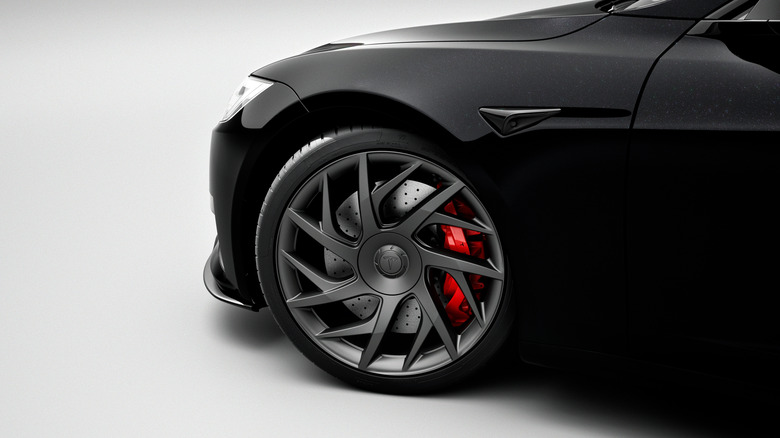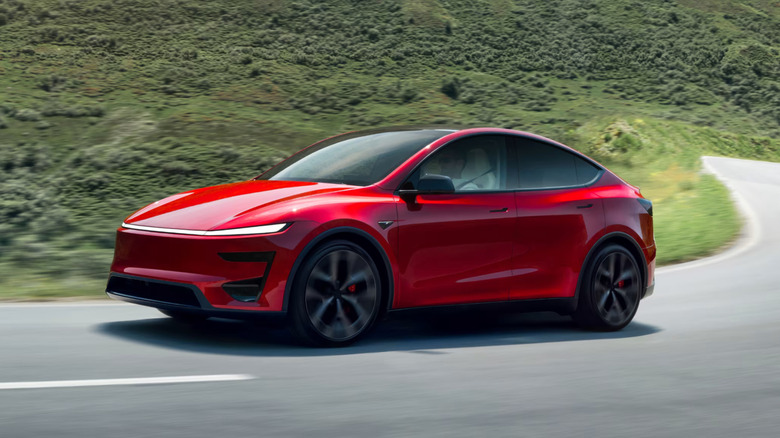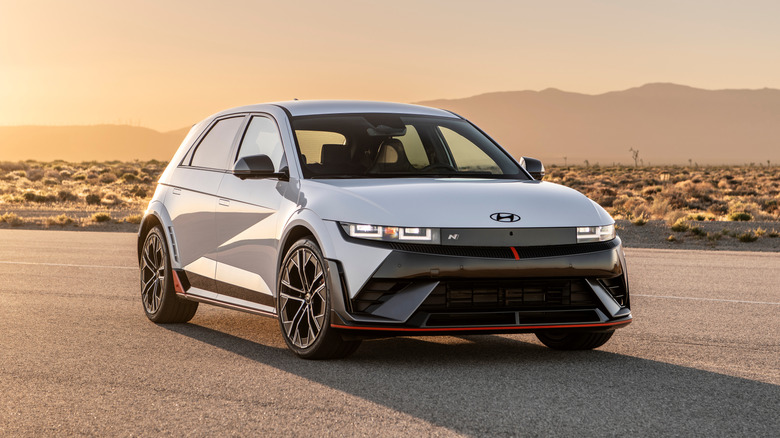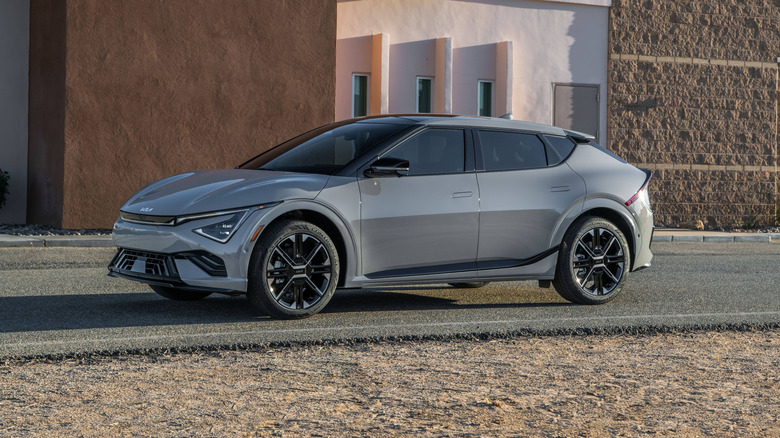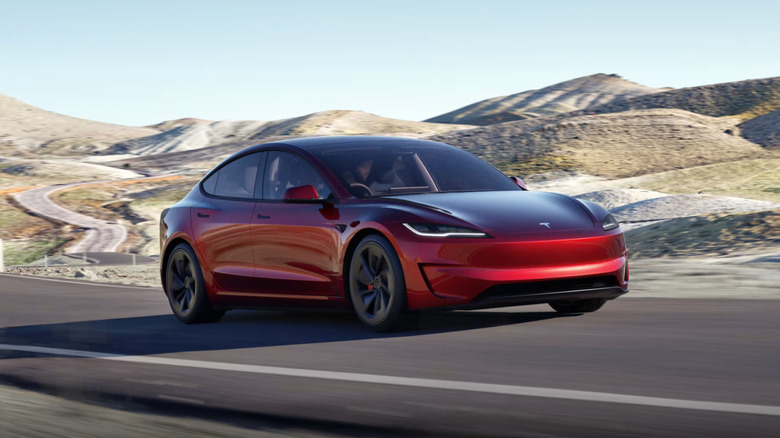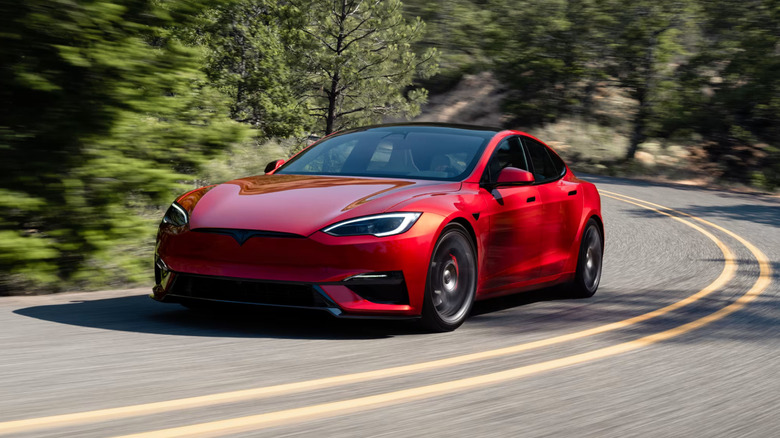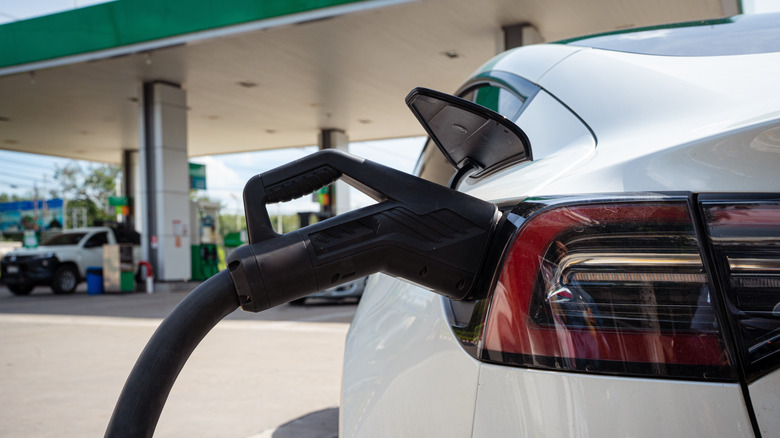5 Of The Fastest EVs Under $100K, Ranked By Speed
Divisive as they are, EVs undoubtedly changed the performance game. Even the cheapest electric cars provide exceptional acceleration off the line, with sub-5-second 0-60 times becoming the norm, rather than the exception. A great example is the 2025 Volvo EX30 Twin Motor. The 422-hp family crossover costs just $46,195, yet it sprints to 60 in crazy quick 3.4 seconds!
But the EX30 reveals another, not-so-fortunate truth — EVs usually have low top speeds. Volvo's EV is blazingly fast off the line, yet its top speed is limited to only 114 mph. For comparison's sake, the 2025 Mazda CX-50 Turbo will hit 142 mph, despite having 'only' 256 hp. The same is true for most gas-powered crossovers.
Sure, there are reasons why EVs are slow at the top end. They usually have only one speed, and batteries that could overheat or run empty very quickly. However, it can be done — without spending Rimac Nevera R money. In fact, there are quite a few affordable EVs that will hit 155+ mph without breaking a sweat and get you there incredibly quickly.
In this piece, we'll give you some of the fastest EVs that cost under $100k. Top speed will play the biggest role in this list, but if it's close between two vehicles, the official 0-60 time will decide the position. Got it? Let's quickly catapult to three-digit mph figures!
2026 Tesla Model Y Performance (0-60: 3.3 seconds, 155 mph)
At $59,130, the Tesla Model Y Performance holds the cheapest ticket to 155 mph — at least when it comes to EVs. Not only that, but it's cheaper than most of its closest performance crossover rivals — the Hyundai Ioniq 5 N, Chevrolet Blazer EV SS, and Kia EV6 GT. The Ford Mustang Mach-E GT is cheaper ($56,490), but its top speed is limited to just 124 mph. Like most Teslas, it has good range, too. Even with a relatively modest 84-kWh battery, the Model Y Performance can travel 306 miles on a single charge.
The Model Y Performance isn't just about top speed. Thanks to its 460-hp dual-motor drivetrain, it produces serious shove off the line, reaching 60 in supercar-like 3.3 seconds. Tesla also reworked the adaptive suspension of the 2025 model to improve handling in the corners. The Model Y Performance now has performance springs, new anti-roll bars, and bushings, with Tesla also meddling with the suspension geometry.
Of course, the Model Y is a crossover first, performance car second. So, as always, it's very spacious inside, with enough room for adults on both rows, and a big, useful trunk. It can even tow up to 3,500 pounds — not a bad figure for an electric performance crossover. Yes, the dashboard is still very minimalistic — most of the functions are controlled via the massive 15.4-inch center touchscreen. Hey, at least you can watch movies and play games while charging at a Tesla Supercharger!
2026 Hyundai Ioniq 5 N (0-60: 3.25 seconds, 163 mph)
Lancia Delta HF Integrale looks, Ferrari performance, video-game-like fun that ignites the boy racer in you — the Ioniq 5 N isn't the fastest EV, sure, but damn it's unique. Hyundai really tried to differentiate its offering from other performance EVs, turning the Ioniq 5 N into a real track star.
Truly, the Ioniq 5 N has no right to be that exciting and fun to drive. It handles beautifully in the corners, with agility that defies belief considering it weighs 4,849 pounds. You can also make it feel like a hot hatch — there is a special mode with faux gear changes and sounds that are totally believable. You'll feel the transmission changing gears, hear the engine revs drop, and even hit the rev limiter. Yes, it gets old quickly, but you must give props to Hyundai for trying. The Ioniq 5 N is quicker than a modern hot hatch to 60, hitting the mark in 3.25 seconds. It also has a top speed of 163 mph — more than enough to fully enjoy track days. It's all thanks to the dual-motor, 641-hp drivetrain, powered by an 84-kWh battery.
Unfortunately, Hyundai's 800V architecture isn't all that efficient, so the range is just 221 miles. This matters, because the Ioniq 5 N is also a very practical daily driver. It has a spacious, well-executed cabin with lots of storage spaces, a big trunk, and useful tech inside. The price, about $68,000 for the 2026 model, is also stupendously high, especially compared to the Model Y Performance.
2026 Kia EV6 GT (0-60: 3.2 seconds, 166 mph)
Not a fan of the Ioniq 5 N's boxy, retro-sci-fi design? You can have pretty much the same car with a more futuristic, predatory appearance — the Kia EV6 GT. This isn't an intellectual property case, as Hyundai and Kia operate under the umbrella of the Hyundai Motor Group.
So, much like its sibling, the EV6 GT has a dual-motor drivetrain that produces 641 hp. That's enough for a thunderous 0-60 sprint of 3.2 seconds and a top speed of 166 mph. Why the higher top speed compared to Hyundai's offering? It's probably because the EV6 GT has a lower drag coefficient of 0.28 Cd, compared to Ioniq 5 N's 0.313 Cd. Is it fun, though? Well, Kia has integrated the same faux gear shifts and engine noises in the EV6 GT, which add to the experience.
Much like the Ioniq 5 N, though, the $65,295 EV6 GT is a tough sell. Thanks to its more slippery body, it has a slightly longer 231-mile range, but that's still a far cry from the Model Y Performance. You can get a longer 271-mile range if you opt for the GT-Line AWD, which has a respectable 320 hp. However, it's limited to a top speed of only 117 mph.
We guess most people will be fine with the limitation, as the GT-Line AWD is still quick (0-60 in 5 seconds). The EV6 is also a practical car, with a spacious interior, lots of storage cubbies, and excellent tech integration.
2026 Tesla Model 3 Performance (0-60: 2.9 seconds, 163 mph)
At $56,620, the Model 3 Performance costs less than its crossover sibling, the Model Y Performance. Yet, it's by far the better option for those looking for a high-performance EV. Tesla equipped its performance sedan with a more potent 510-hp, dual-motor drivetrain, which propels it to 60 in just 2.9 seconds. That's significantly faster than the base Porsche 911, and as quick as the outstanding 2025 Porsche 911 Carrera GTS hybrid. The Model 3 Performance also hits 163 mph, or 7 mph more than the $83,595 BMW M3 Competition xDrive.
Yes, the Model 3 Performance doesn't have engine noise. Nor a gearbox. But come on, there is simply no quicker vehicle at its price point — it's not even close. And it's not like everything falls apart once you push it in the corners. Yes, Tesla's electric M3 rival isn't very engaging or joyful, but it can go around corners faster than its price point would suggest.
The interior, especially after the Highland upgrade, feels more luxurious than before, too. And it's not just the materials — Tesla improved the sound insulation and ride quality, bringing it closer to its premium rivals. Sadly, anyone who sat in the back seats can attest to the high floor, which renders the Model 3 useless for longer journeys, especially for people with knee problems. It's a shame, because the 309-mile range is rather useful. Also, there are the usual Tesla irritations, like the lack of signal stalks, which Tesla will be happy to retrofit for $595.
2025 Tesla Model S Plaid w/ Track Package (0-60: 1.99 seconds, 200 mph)
The Model S Plaid made more headlines than perhaps any other vehicle in the past five years. Hardly surprising, as it starts at just $96,630, yet it can beat pretty much any vehicle on the drag strip, save for the astonishing, 205-mph Lucid Air Sapphire and hypercars like the Rimac Nevera R.
Yes, the Model S has a ton of deficiencies. And yes, it's an antique vehicle, dating back to 2012. But when it launches, all arguments go quiet. 0-60: 1.99 seconds. Top speed: 200 mph with the $19,500 Track Package. Yes, that would push the price beyond $100k, but the 163-mph top speed of the regular Model S Plaid is still alright. Oh, and you should get the Track Package because it improves the mega-performance sedan in many other areas. It brings stickier Goodyear Supercar 3R tires, forged wheels, carbon ceramic brakes, and forged calipers with high-performance pads — important in a car that accelerates as well as it stops.
To achieve its preposterous performance figures, the Model S Plaid is equipped with a ridiculous tri-motor, 1,020-hp drivetrain. It also makes ludicrous 1,050 lb-ft of torque, more than your heavy-duty truck. Better yet, the Model S Plaid is also stupendously efficient — its 95-kWh battery provides a useful 359-mile range. You'll now likely point out that the Lucid Air Sapphire has a longer 427-mile range, reaches 60 in eye-opening 1.89 seconds, and has a nicer cabin. Well, the Air Sapphire costs $250,500, so the Model S Plaid still wins the performance-to-dollar ratio.
How did we rank these EVs?
For this piece, we gathered official top speed and acceleration figures from manufacturers. Then, we ranked them in ascending order (slowest to fastest) mainly according to their top speed, though when it was a close call, 0-60 times also played a role. This is because most EVs are stupendously quick off the line, but not all of them are fast at the top end. Still, with a 0.3-second quicker 0-60 time, the Model 3 Performance is rated higher than the Kia EV6 GT, because 3 mph at the top end doesn't make a difference in the real world.
